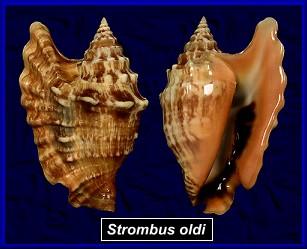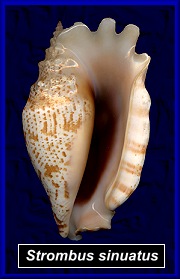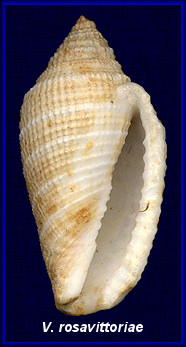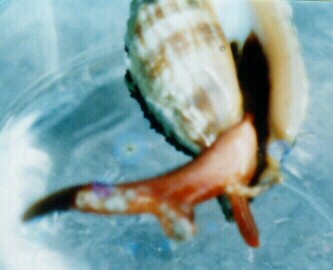| Strombus oldi - A Retrospective |
| By Harry G. Lee |
 I remember it well. There they were - a half-dozen
wave-worn conch shells scooped from the sandy shores of the Horn
of Africa. A few weeks before this momentous revelation, the
American Museum of Natural History had received some shells from
the vicinity of Obbia, Somalia collected about six years earlier,
and these conchs were certainly the centerpiece of the small
collection. I remember it well. There they were - a half-dozen
wave-worn conch shells scooped from the sandy shores of the Horn
of Africa. A few weeks before this momentous revelation, the
American Museum of Natural History had received some shells from
the vicinity of Obbia, Somalia collected about six years earlier,
and these conchs were certainly the centerpiece of the small
collection.I was a medical school freshman/volunteer worker in the Department of Living Invertebrates in the largest museum in the world, and Bill Old, the departmental scientific assistant (Collections Manager is a more apt and contemporary approximation), knew I’d be dazzled and perplexed by the contents of the drawer he had pulled out - palm-sized shells looking like ruggedly-sculpted Strombus laciniatus Dillwyn, 1817,* but with a broad chocolate stripe inside each aperture. None of the shells was spared damage from the East African surf, and the outer lip seemed to have been particularly vulnerable. While Bill (me, too) suspected this species was un-named, he pointed out, with some irony, that he couldn’t place this new taxon in a genus (Strombus vs. Lambis) based on the material before us - it might or might not possess digitations on the labrum (fingers on the shell’s outer lip), the feature which rather arbitrarily separates the two genera.
Over the following months, Bill’s boss, Dr. William K. Emerson, Associate Curator, quietly solicited a fine specimen from Mrs. Orville Davis of Philadelphia, produced a manuscript description of this conch, and sent the paper to Dr. R. Tucker Abbott, then in the Pilsbry Chair at the Academy of Natural Sciences (also Philadelphia) and founder of the nascent irregular journal Indo-Pacific Mollusca. Not long before the submission, Tucker had published his monograph on Strombidae in this journal, so it seemed a natural destination for Emerson’s paper. Strombus oldi was published in a two page supplement to Tucker’s monograph and was sent to I. P. M. subscribers on April 30, 1965. I don’t remember if this act of patronymy took Bill (Old) by surprise, but I’d like to think so. To this day Strombus oldi Emerson, 1965 is arguably the finest and rarest Recent species in the family. After medical school, internship, residencies, and military service, I found myself studying in Ethiopia - and I hadn’t forgotten my years at A.M.N.H.! Despite a most unpropitious geopolitical scenario, I successfully negotiated visas for myself and my wife, Kitty, to visit Ethiopia’s "neighbor," The Somali Democratic Republic after about six months of hassle one can only experience in the Third World. Our destination was Mogadishu, on the coast and in the range of Bill Old’s Conch, a species which, by 1972, had become a bona fide holy grail for conchologists around the world. Well, in January, 1972 we spent a week in and around Mogadishu. Travel was restricted due to "civil unrest." (The hundreds of Red Chinese "advisors" seemed to be unencumbered by this policy, while Western diplomats, workers, and tourists were essentially tethered to Mogadishu.) The furthest we traveled was Gezira, about 20 km. south of Mogadishu. We did plenty of snorkeling, and I was able to gather about 200 species of marine shells, including live Naria marginalis (Dillwyn, 1817), a prized East African endemic, but no S. oldi was seen. The Somali beach boys we inevitably encountered were shown pictures of the great conch, and some seemed to recognize the shell. (All, however, volunteered to take down payments for future delivery.) Despite dozens of promising leads, neither our little colleagues nor we were able to come up with the prize species. One of our traveling companions, the Embassy
Physician in Addis Ababa, where we and he lived, took an
Months later I got acquainted with Rosavittoria Todaro, and Italian lady working in Mogadishu with the United Nations. I saw her name (and fascinating address!) in Tom Rice’s Of Sea and Shore magazine and wrote her immediately. We were in frequent contact from 1972 until recently. I saw Rori become a fine conchologist during those two decades. After a little warm-up time, she got a handle on the S. oldi situation. The shells began coming to her by caravan from north of Mogadishu. By 1990 I reckon she had sent me four dozen fine specimens, and I exchanged them widely and profitably. Volutocorbis rosavittoriae Rehder, 1981 is named in honor of this inspirational and industrious naturalist. It is just one of many species she brought to light. |


